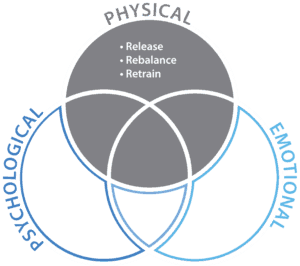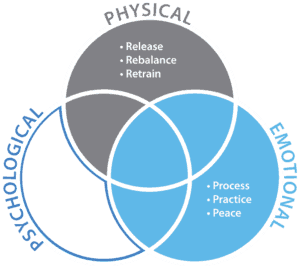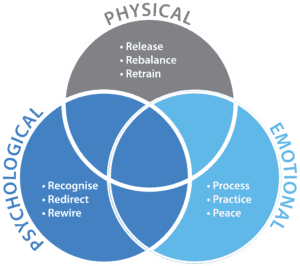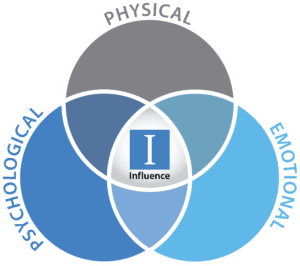The P.E.P. Approach to Stress Reduction
![]()
In this post I’m going to be describing The P.E.P. Approach and how it can be used to significantly reduce your stress, anxiety and fatigue levels.
Before looking at what we can do to help these situations, firstly we need to fully understand the problem.
The problem – The self-fuelling stress cycle
When we’ve been under stress for some time the whole process typically develops into a self-fuelling cycle. The symptoms of stress cause further stress and so we easily become stuck in this destructive cycle.
Physically
The physical symptoms of stress – pain and tension, headaches, Migraines, digestive issues, poor quality sleep, wired feeling in the body, tiredness and fatigue etc etc, are all stressful in themselves and so further feed the stress cycle.
Emotionally
Whilst under stress we become far more emotionally sensitive and may find ourselves reacting or overreacting.
These emotional reactions can take longer than we might expect to clear from our system, only to find ourselves going into the next reaction / overreaction. This increased emotional sensitivity caused by stress, then creates even more stress chemistry further fuelling the cycle.
Psychologically
Whilst under stress the nature of our thoughts actually change. At a subconscious level the system feels in danger and so we become more vigilant, on the lookout for more potential danger.
This shows up as increased mind chatter and more “what if” thoughts, what if this happens?, What if that happens?, What if things turn out this way or that way?
Internal scary movies
The outcomes we imagine are usually challenging, like internal scary movies, and although they’re just imaginations, the stress centre picks them up as potentially real and so prepares our system for a fight or flight stress response, producing even more chemistry which further fuels the cycle.
Maybe it’s becoming clear now, how the symptoms caused by stress, then create even more stress, setting up the perpetual cycle?
An unconscious training
This whole process is like an unconscious training for the limbic system (stress centre), To the point where it’s maintaining a consistent low-level stress response.
This has a disrupting affect on all body systems. As part of the fight-or flight response, stress actually steals energy from other body systems in an unconscious attempt to protect us.
This is manageable in the short term, but when maintained, this redirecting of energy becomes completely destructive on the system. It’s like the needle on the dial has gone into the red and got stuck there.
So what’s the answer?
At this point we need to re-train the limbic system (stress centre) to get the needle to drop down out of the red! We can look at all the symptoms of stress as messages from the system that things have gone out of balance and need to change.
Reverse-engineering
After working with hundreds of people experiencing high stress levels, I’ve found the most effective way to do that retraining is to focus on the same three areas – Physical, Emotional and Psychological.
When we focus on reducing stress in those three key areas, we’re able to reduce the stimulus on the oversensitive stress centre, allowing it to recalibrate (bring the needle down out of the red), Which shows up as a significant reduction in all of the stress-related symptoms.
Apply for a free strategy session here
The physical component
Remember that the system has become unconsciously trained to produce an efficient stress response and at this point that has become such a neurological habit that the system has almost forgotten the alternative, the relaxation response.
From a nervous system perspective it’s like we have one foot on the accelerator whilst the other foot is firmly pushing on the brake, causing a huge drain on resources.
Within the Physical component of the approach we focus on a set of simple tools and practices that can be used regularly to release stress from the system.
Over the years I’ve identified and developed a set of physical practices that quickly and efficiently release stress from the system.

The focus here is on:
Release
Rebalance
Retrain
These physical practices are designed to remind the system of the currently unfamiliar relaxation response.
With just a few minutes of practice we can learn to Release built up stress from the system.
By encouraging the system to relax and Rebalance in this way we can start to give some relief to the nervous system, which in turn has a beneficial effect on the entire system.
If we then continue using these quick and simple tools as part of a regular practice we can start to Retrain the system into a healthier and more balanced state.
The emotional aspect
I mentioned earlier that when we’re under consistent stress our emotional reactions are more easily triggered and have more of an adverse affect on the system, further fuelling the cycle.
Within the emotional component of the approach we learn to use a technique that we can apply to calm our emotional reactions.
This technique takes just minutes to apply and you can literally feel the difference as you release the “charge” behind that particular emotional issue.
The research shows that this type of technique has a rapid calming effect on the Limbic System (stress centre), and becomes another valuable part of the re-training process.
Without the right tools at hand, most of us learn to suppress our emotional reactions. The charge behind these reactions tends to build up in our system to the point where we’re not even sure what’s troubling us.

The focus here is on:
Process
Practice
Peace
When we learn to effectively Process our emotions in this way, we take back a level of control over our emotional state.
If we then Practice this regularly to the point where it becomes second nature to use the process, not only do we feel a huge amount of relief, but it also has an empowering effect, knowing that we have tools at hand and we’re not going to be hijacked by our emotional reactions.
If we then continue using this simple emotional processing technique to release the charge behind those reactions we bring about an increased sense of Peace to our system and in all areas of our life.
The Psychological side
I mentioned earlier, the psychological part of the self fuelling cycle, where stress encourages us to think in more stressful ways (increased vigilance) and those thoughts generate even more stress, causing us to loop and get completely stuck.
The research shows us that the brain is very adaptable in its nature, the term neural plasticity refers to the brain’s ability to adapt and change depending on how we’re using it.
This neural plasticity works in both ways and when under stress it’s common for the brain to develop some destructive habits (habitual stressful thoughts, internal scary movies, catastrophising etc etc..). So at this point some neural retraining becomes necessary.

The focus here is on:
Recognise
Redirect
Rewire
With the right training we can learn to Recognise the types of thoughts that are generating low-level stress.
Using a structured approach we can learn to Redirect the thought process and intentionally change perspective in the moment.
We can take advantage of neural plasticity, breaking down destructive neurological habits and replacing them with healthier responses. Again consistency is the key here, but with practice we can literally Rewire the brain to operate in a healthier way.
The Combination is the key!
When things have been out of balance for some time and the process has become self-fuelling, I’ve found that it’s vital to be focussing in these 3 key areas – Physical, Emotional and Psychological and to do that simultaneously if we want to see some real and lasting change.
Otherwise if we were to focus in just one of these areas, it’s so easy to be unconsciously tripping yourself up in the other areas.
This, in my opinion is why I’ve been able to help so many people who’d previously tried just about every other approach out there, without success.

Apply for a free strategy session here
The whole is greater than the sum of its parts!
When we focus in these 3 key areas there is a synergistic effect that takes place, each area supports and positively influences the others.
We learn to firstly release built up stress from the system and do that consistently, along with then learning to generate less stress on a daily basis.
This, if practised over a period of time, sends such a different message to the system. The system realises it’s not under attack and the needle drops down out of the red.
The system then starts to respond in a very different way, body systems re-balance, symptoms resolve, energy returns and life generally gets easier in all areas.
Over the years I’ve witnessed people literally transform their lives by focussing on this combined approach!
Does it all sound like too much?
This might all sound like a lot to do, but if you’re serious about changing your situation, in my opinion and experience, this is exactly what it’s going to take.
If you consider quite how much time you currently waste on stressing about this issue or that issue.
How much mind chatter you currently experience, along with the broken sleep, fatigue and other symptoms, surely it makes sense to invest some of that wasted time and effort into positively changing your situation?
A step-by-step system
For those who are serious about transforming their lives, over the years I’ve developed this approach into a step-by-step system that anyone can follow.
If you’d like to find out more about this approach and how you could specifically use it to change your situation, each month I put some time aside and offer a small number of free strategy sessions.
During the session I can share more on this subject and give you some advice on where to focus in your situation.
Apply for a free strategy session here
To your good health
Russell
Russell Stubbs
International Health Coach & Therapist
